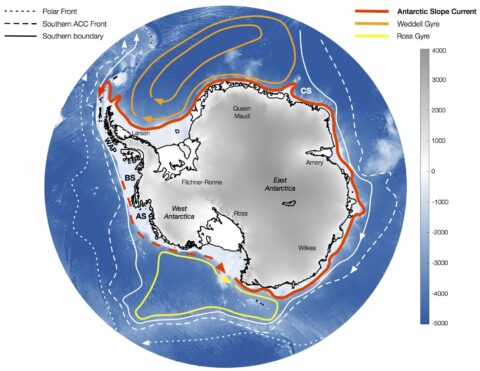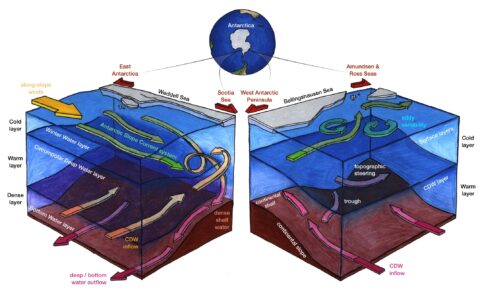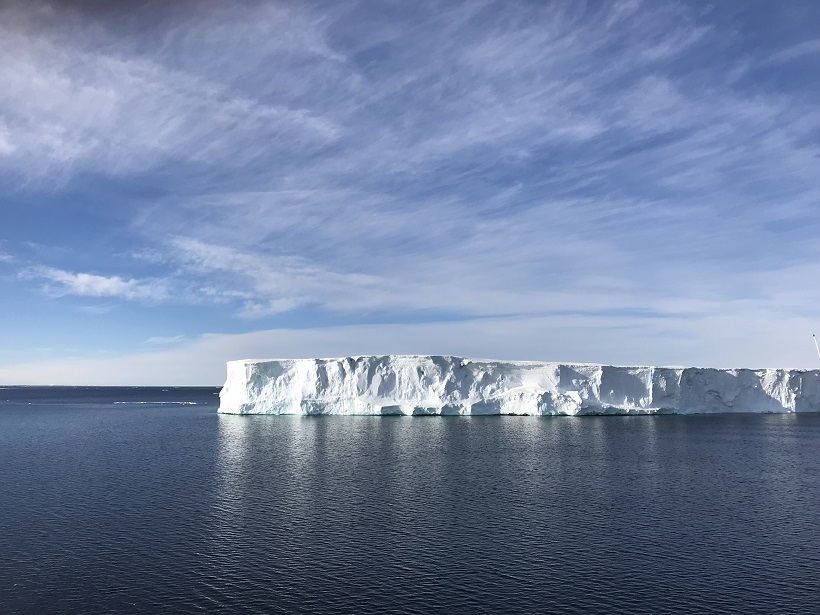The Antarctic Slope Current (ASC), which rings the continent, is a fascinating ocean flow for its local, regional, and global influence. A recent paper in Reviews of Geophysics describes the spatial and temporal variability of the ASC and its influence on the global climate system. Here, the authors of the paper give an overview of our current understanding of the ASC and suggest where further research is needed.
What are the main characteristics of the Antarctic Slope Current?
The ASC is a narrow, westward-flowing boundary current that is found over the continental slope almost everywhere around Antarctica. The ASC often separates distinct water properties found offshore and over the continental shelf. In particular, the ASC typically marks the boundary between warm waters that sit off-shore below the surface (at roughly 500 meters depth) and colder shelf waters.
Furthermore, the ASC is a dynamic feature that can vary over time scales as short as a tidal period, while it also responds to seasonal variations in surface forcing and modes of climate variability such as the El Niño Southern Oscillation (ENSO).

How does the ASC affect the Antarctic region?
The ASC is the gateway between the continental shelf and the open ocean.
The ASC is the gateway for exchange between the continental shelf and the open ocean everywhere around Antarctica. This is remarkable because the Antarctic shelves are locations where water with unique temperature and salinity properties are produced and exported to the global ocean.
The dynamics of the ASC determine both where open ocean waters are supplied to the shelf and where shelf waters are discharged. This on-shore and off-shore exchange across the shelf break, while balanced in a global sense, need not happen at the same location. The zonal, or along-slope, transport of the ASC is crucial for connecting different regions of the Antarctic margins. The ASC can even carry icebergs calved in the Ross Sea counter-clockwise around the entire continent where they eventually feed into the Antarctic Circumpolar Current from the Weddell Sea and melt.

How does the ASC affect processes beyond the Antarctic region?
The ASC is likely to play a critical role in future changes to global sea level. At present, rapid thinning of floating Antarctic ice shelves is largely limited to West Antarctica, a region consisting of the western side of the Antarctic Peninsula and the nearby Bellingshausen Sea and Amundsen Sea. Here, the ASC provides a weaker barrier to the onshore transport of warm offshore waters. Almost all of the thinning in these regions is attributed to melting by warm waters that flood the continental shelf, flow under the ice shelves, and contribute to melt at their base.
In other regions around Antarctica, the ASC shields the continental shelf and floating ice shelves from these warm water intrusions. Changes to the structure or the strength of the ASC could potentially lead to ice shelves in East Antarctica being susceptible to thinning and retreat.
What have been some of the recent advances in understanding the ASC?
Various technological advances have greatly increased our understanding of the ASC over the past decade or two.
Various technological advances have greatly increased our understanding of the ASC over the past decade or two.
Observational techniques, such as autonomous vehicles and instrumented marine mammals, have allowed measurements of the ASC to be collected over longer periods of time and during seasons when ship-based observations have historically been sparse.
New remote sensing techniques that are able to select radar returns from leads in sea ice have enabled quantification of the ocean’s sea surface height variability at the Antarctic margins, a property that is linked to surface current speeds.
All of these measurements have provided new insight into the variability of the ASC across a range of spatial and temporal scales. This has been coupled with much higher resolution modeling efforts that have further revealed the turbulent nature of the ASC and its associated transport.
What are some of the challenges with observing and modelling the ASC?
The ASC is a relatively narrow and variable feature, typically spanning only 10 or 20 kilometers across the continental slope, yet it may respond to forcing over much broader scales. In the Weddell Sea and Ross Sea, the ASC acts as a boundary current that moderates the response of the wind forcing integrated over the entire surface of these large polar gyres.
The ASC even responds to remote forcing such as fluctuations in tropical sea surface temperatures related to ENSO variability. This variability gives rise to modulations in global atmospheric wind patterns that can intensify or weaken the strength of the ASC.
Resolving both small-scale turbulent processes that ultimately govern the exchange of properties with the continental shelf, while capturing feedbacks due to large-scale forcing patterns remains a challenge for both observational and modeling studies.
How may the ASC be affected by a changing global climate?
Our understanding of how the ASC will evolve in a changing global climate remains rudimentary.
Our understanding of how the ASC will evolve in a changing global climate remains rudimentary.
Over inter-annual to decadal timescales, changes in atmospheric wind patterns are likely to have the most profound effect on the ASC and the Antarctic margins. Changes in surface winds could cause warm offshore waters to either deepen or shoal in the water column, which in the latter case, could allow warm waters to flow on to the continental shelf and towards the base of ice shelves.
Over longer periods, changes to the patterns of sea ice extent and melting, the flux of freshwater coming from glacial melt, and the distribution of evaporation and precipitation, will all modify water mass modification in the Southern Ocean that influences the strength of the global overturning circulation and the ocean’s capacity to take up heat and carbon dioxide.

What are some of the unresolved questions where additional research, data, or modeling is needed?
Observational coverage of the Antarctic margins has improved greatly in the past few decades, yet many regions remain poorly sampled, making it difficult to distinguish between changes related to a turbulent, variable circulation and long-term trends.
Another topic of interest is the connectivity of the ASC. For example, how are changes occurring in one region, such as increased glacial melt in the Amundsen Sea, communicated downstream by the ASC and how do these remote processes impact other regions?
Finally, there is a great need for interdisciplinary research that implements our improved dynamical understanding of the ASC in studies of regional biogeochemistry, ecosystem dynamics, and sea ice and ice sheet evolution to improve our ability to model both past and future changes in Antarctic climate.
—Andrew F. Thompson (email: [email protected]), Environmental Science and Engineering, California Institute of Technology, with contributions from co-authors
Citation:
Thompson, A. F. (2019), The ocean’s gateway to Antarctica, Eos, 100, https://doi.org/10.1029/2019EO114873. Published on 31 January 2019.
Text © 2019. The authors. CC BY-NC-ND 3.0
Except where otherwise noted, images are subject to copyright. Any reuse without express permission from the copyright owner is prohibited.

